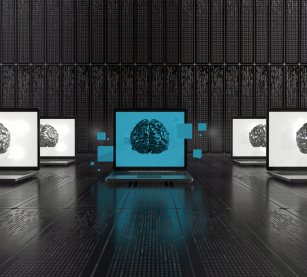The Macro Market & Workplace Realities
2024 promises to be a year of new strategies amid an ongoing human capital shortage, the continued maturing of AI, and an evolving workforce. In this first part of our trends report, the MBO Partners leadership team weighed in on these and other critical aspects of today's workforce.
The Macro Market
In terms of the workforce, all industries and business sectors see three issues: a human capital shortage, a recession that hasn't materialized, and the reality of artificial intelligence (AI).
AI Continues to Grow
January predictions often claim that the coming year will be remarkable. As far as AI goes, 2024 does promise to be a turning point year for business. Just as leaders scratched their heads over desktop computers in the 1980s and then the internet ten years later, many companies are figuring out the best use of AI. And like its predecessors, it is shaking things up big time.
We will see AI become table stakes in 2024. Any enterprise that doesn't incorporate AI effectively into the business will drastically shrink its competitive footprint. In terms of the workforce, the time has come to determine how AI sits in relation to employees and contingent labor. Can it supplement the workforce?

On the talent side, 47% of independent professionals who responded to our State of Independence survey are either very or somewhat familiar with AI. Independents who fail to position themselves favorably relative to AI will have a more challenging time getting engagements with enterprise clients. The good news is that contractors with knowledge of AI as a business tool can augment their businesses by offering consultative services to companies that want to implement AI but aren't sure how.
The Recession Market Evaporates
I'm quite bullish on the potential for a strong 2024 as it relates to the need for independent talent. The US economy will ramp up this year, increasing the demand for human capital, particularly independent workers.
Miles Everson, Chief Executive Officer
The media-manufactured doom and gloom about a recession that never materialized created a lot of uncertainty across US industries in 2023. Still, interest rates remained high, access to capital was still constrained, and uncertainty lingered. Companies don't like uncertainty, and most leaders took a careful approach in 2023 as they waited for the predicted economic calamity.
Though the recession was more fiction than fact, enterprises are still likely to be wary of stepping out too far too fast. The economy may be choppy, and leaders will want to keep their options open. This means that the use of contingent labor will continue to increase in 2024. In Q1, we expect to see companies in some sectors allocate budgets for the engagement of high-end independent contractors with business-critical skill sets. Across the board, independent talent engagement is likely to take place in earnest starting in Q2.
Enterprises can get a running start in Q1 by determining the business-critical skills needed from high-end independent talent and successfully engaging the right people.
Human Capital Scarcity Continues
The apparent scarcity of human capital in the US today is rooted in four factors:
Birthrate Over the Past 70 years
To deal effectively with this issue, leaders must take the time to understand human capital macro trends and appreciate that a strategy that worked in the past will not take them forward into the future because they will not have enough employees. In fact, the perception of human capital scarcity is due in large part to enterprises' traditional approach to talent acquisition-that is, that "talent" means employees. To find the people and skills they need to grow the enterprise, they must create a total workforce strategy that includes independent talent.
Workplace Realities
The dust is settling on work topics like AI and remote work as controversy recedes and action is taken. As enterprises and workers adopt strategies and tactics that pave the way to the workplace of the future, these are some of the realities in today's workplace.
AI Works as a Colleague
Our clients are deeply invested in how to best leverage the power of AI into their future of work strategies. The savviest enterprises are already tapping into independent professionals – the ultimate resource well for in-demand professionals – to guide their ever-evolving work plans and strategies and building strategic talent pools and benches to serve future needs.
David Cassar, Chief Revenue Officer
Our data shows that while people are aware of AI, particularly generative AI (e.g., ChatGPT and MidJourney), nobody seems afraid that it's going to take their job. Rather, many workers, both employees and independent contractors, use AI as a "colleague." Most are Millennials or the digital-native Gen Zs, whose digital tools have always been integral to daily life.
With the right prompt, generative AI can accomplish tasks in minutes (or seconds) that require hours (or days) for humans to accomplish. The roles it plays in today's workforce include:
-
Research assistant
AI excels at using the internet to assist in researching a human-directed topic.
-
Brainstorming partner
Generative AI can spark creativity by generating suggestions spark ideation.
-
Idea tester
AI can scrape the entire internet to test your idea against what already exists.
-
Advisor
AI can help identify challenges or do SWOT analyses to unearth potential flaws in ideas or potential strategies.
-
Marketing partner
Independent professionals and job seekers can use AI to fine-tune their resumes on specific roles and jobs.
All of these roles are additive rather than supplantive, and workers are becoming increasingly adept at using AI as an indispensable tool to produce excellent outcomes.
Remote Work is Here to Stay
The genie is out of the bottle. Before the pandemic, remote work was already a common model in some business sectors. When lockdown hit the workplace, suddenly, everyone was at home, and all companies had to figure out how to make that work.
Try as they might to turn the ship around and get everyone back into the office, many companies will not see a return to their pre-pandemic status quo. It's time to brace or embrace: As they mandate or try to incentivize return to physical workplaces, they are getting pushback from workers. Basically, there are two choices:
In either case, companies need to be able to ramp up people and help them get things done with minimal human assistance. It will be critical to give employees and contractors the ability to self-serve for onboarding as well as for getting their work done. As a result, by using AI, the way knowledge is managed will be disrupted this year, largely because of the attempt to force people back to the office.
Data-Based Decision-Making is Taking Hold

Decision-making based on data is fast becoming the only way to build and achieve goals in the enterprise. Data assists us with our tasks, drives activity, and drives business. Even veterans who used to do business based on experience and instinct are turning to data for decisions. Because they are accustomed to making data-based decisions from childhood, data-driven actions are easy for younger workers to adopt.
Therefore, bolstered by AI, we will start seeing data-based decision-making become the norm in all business areas.


Diversity is a Business Imperative
Diversity, equity, and inclusion (DEI) programs are part of most, if not all, enterprise HR functions today. with the workforce must be inclusive on multiple fronts, and not limited only to employees. Many companies focus their HR departments on how to implement DEI initiatives for their employees, but they forget that their contract workforce is equally important.
If you don't consider your extended workforce as important or more important than your full-time workforce, you're missing the boat. Successful enterprises become both an Employer of Choice and a Client of Choice for their independent contractors through practical and effective DEI activities.
Side Hustles Reign Supreme
Our 2023 State of Independence research revealed that the number of people (36.6 million) who earn money periodically through independent work at least monthly doubled over 2022. Along with part-time independents, this population represents a valuable skill set and opportunity for enterprises. This population will continue to increase, and organizations need to find ways to tap into these workers to fill specific need slots. Talent who are supplementing their primary employment with part-time or occasional independent work need to figure out how to balance work and life to avoid burnout.
Independents in America (by Type of Worker)
Independents in America (by Type of Worker)
(Data in millions unless otherwise noted)
In Conclusion
Market and workplace realities point to the likelihood that coming into 2024, enterprises are underusing the skill pool available to them. Including a remote work model, powering up the DEI program, and facilitating AI to augment work results are three ways to tap needed skills better. Robust deployment of independent talent, including the occasional independents whose side hustles match your needs, will further power up your workforce.
Part 2 of our trends report offers further insights into 2024 with recommendations to position the enterprise to succeed in the future of work.
Thank you to the members of MBO's leadership who contributed to this report
Miles Everson
Chief Executive Officer

John Dahlberg
SVP, Data Strategy and Governance
Audra Nichols
Chief Operating Officer

John Marcantonio
Chief Product Engineering Officer
Bob Lucas
SVP, Corporate Development
Keaton Swett
VP, Product
Cori McKee
VP, Enterprise Solutions
Kristian Rayner
Director, Enterprise Sales
Dave Cassar

McLean Robbins
VP, Marketing
Fernando Cardenas
Chief Technology Officer
Mick Lee
Chief Administrative Officer
Holly Kehrer
VP, Enterprise Solutions
Thomas Lutrell
Chief Financial Officer
Thank you to the members of MBO's leadership who contributed to this report
Miles Everson
Chief Executive Officer
Bob Lucas
SVP, Corporate Development
Dave Cassar
Holly Kehrer
VP, Enterprise Solutions

John Marcantonio
Chief Product Engineering Officer
Kristian Rayner
Director, Enterprise Sales
Mick Lee
Chief Administrative Officer
Audra Nichols
Chief Operating Officer
Cori McKee
VP, Enterprise Solutions
Fernando Cardenas
Chief Technology Officer

John Dahlberg
SVP, Data Strategy and Governance
Keaton Swett
VP, Product

McLean Robbins
VP, Marketing
Thomas Lutrell
Chief Financial Officer













